Organizational Innovation: Successes, Failures, and Impact Report
VerifiedAdded on 2023/01/11
|7
|1016
|55
Report
AI Summary
This report delves into the multifaceted nature of innovation within organizations, exploring both its triumphs and setbacks. The introduction defines innovation as the creation of new ideas and processes, emphasizing its role in meeting market needs. The main body examines idea generation as the cornerstone of innovation, highlighting the innovation funnel and the importance of systematic idea management. It then presents a balanced view of innovation, outlining its benefits, such as improved productivity, better quality, and expanded product ranges, alongside its challenges, including competition, uncertain commercial returns, and financial constraints. The conclusion synthesizes the discussion, emphasizing the need for organizations to carefully assess all aspects of an innovation before implementation. The report uses references to support its claims and provides a comprehensive overview of the subject.
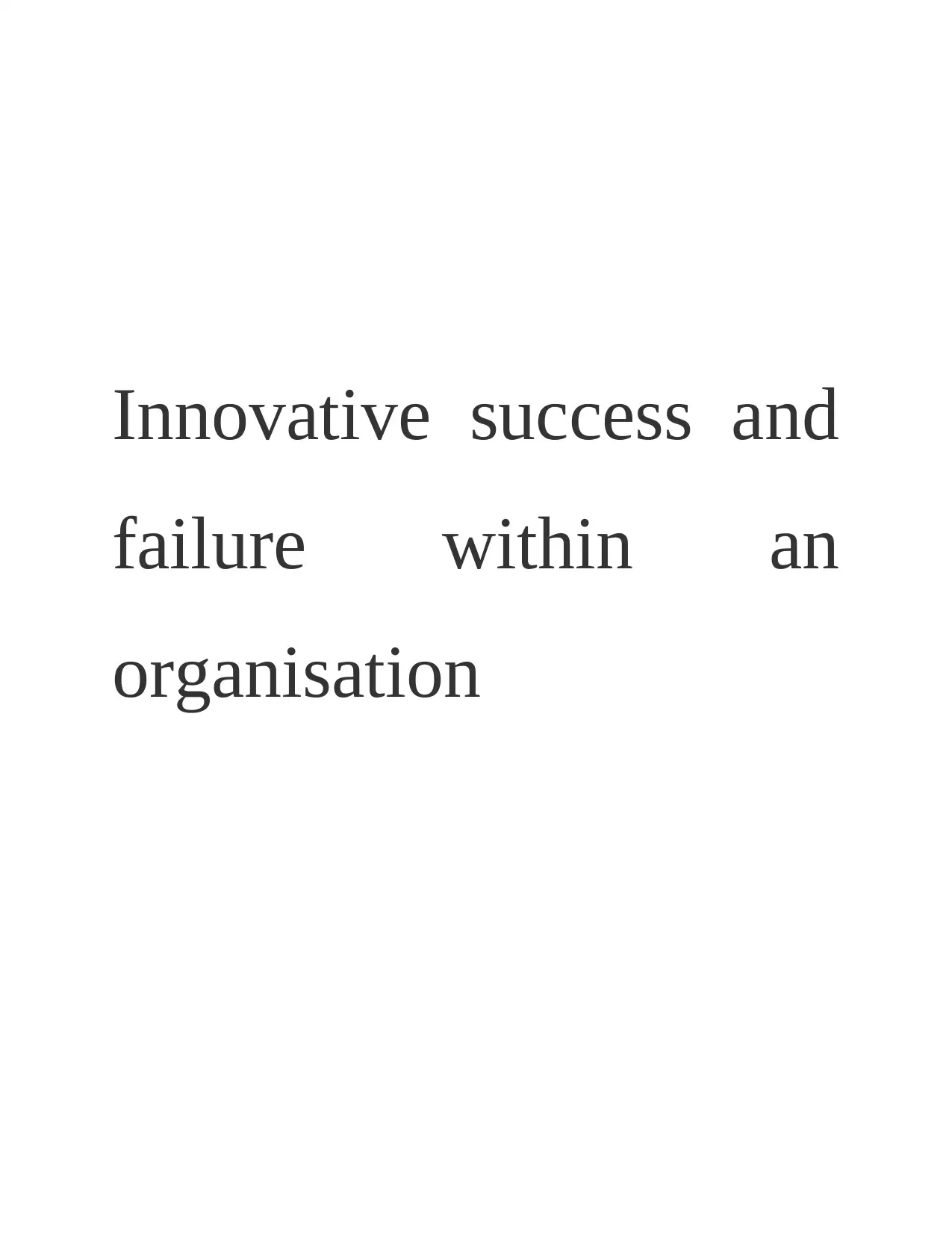
Innovative success and
failure within an
organisation
failure within an
organisation
Paraphrase This Document
Need a fresh take? Get an instant paraphrase of this document with our AI Paraphraser
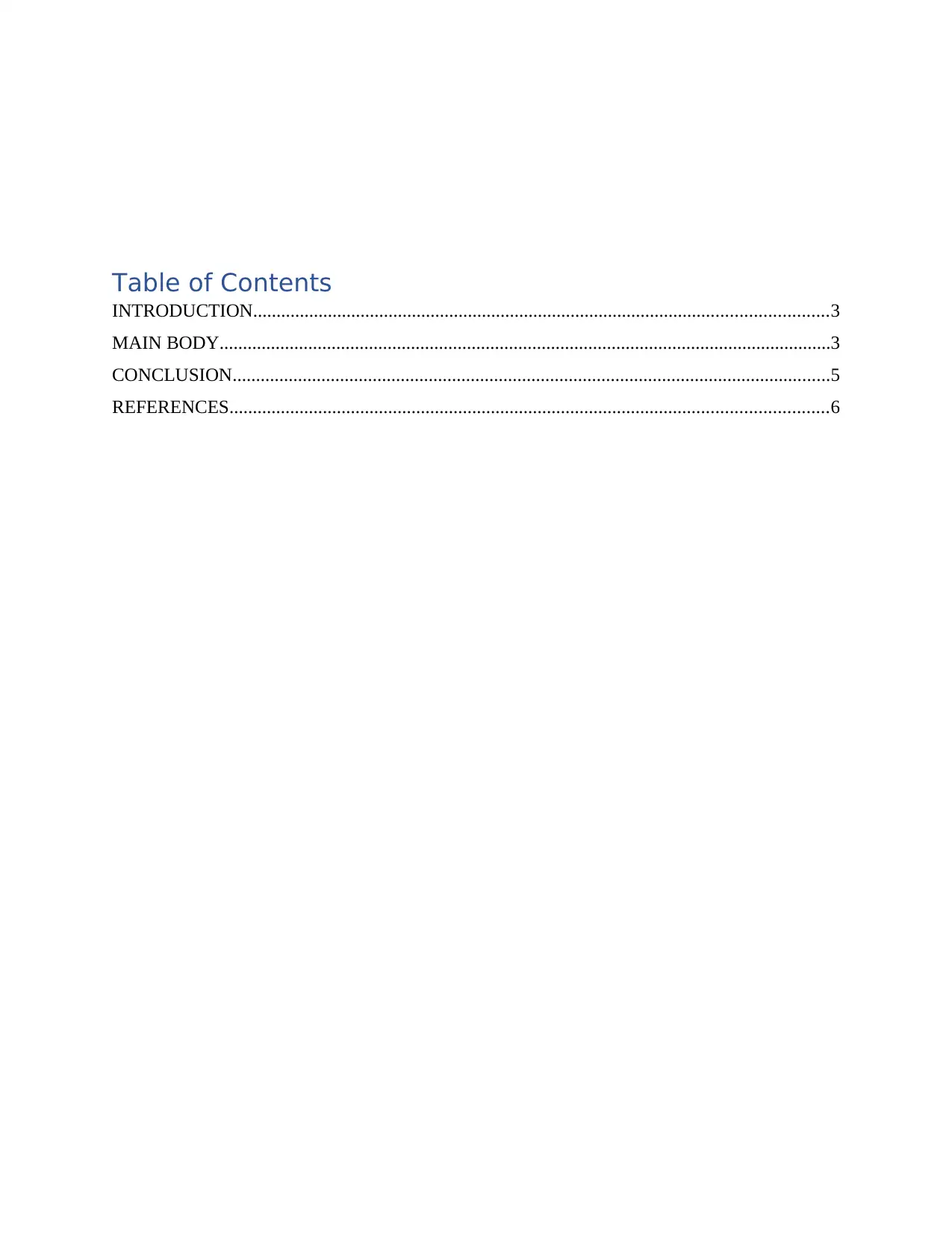
Table of Contents
INTRODUCTION...........................................................................................................................3
MAIN BODY...................................................................................................................................3
CONCLUSION................................................................................................................................5
REFERENCES................................................................................................................................6
INTRODUCTION...........................................................................................................................3
MAIN BODY...................................................................................................................................3
CONCLUSION................................................................................................................................5
REFERENCES................................................................................................................................6
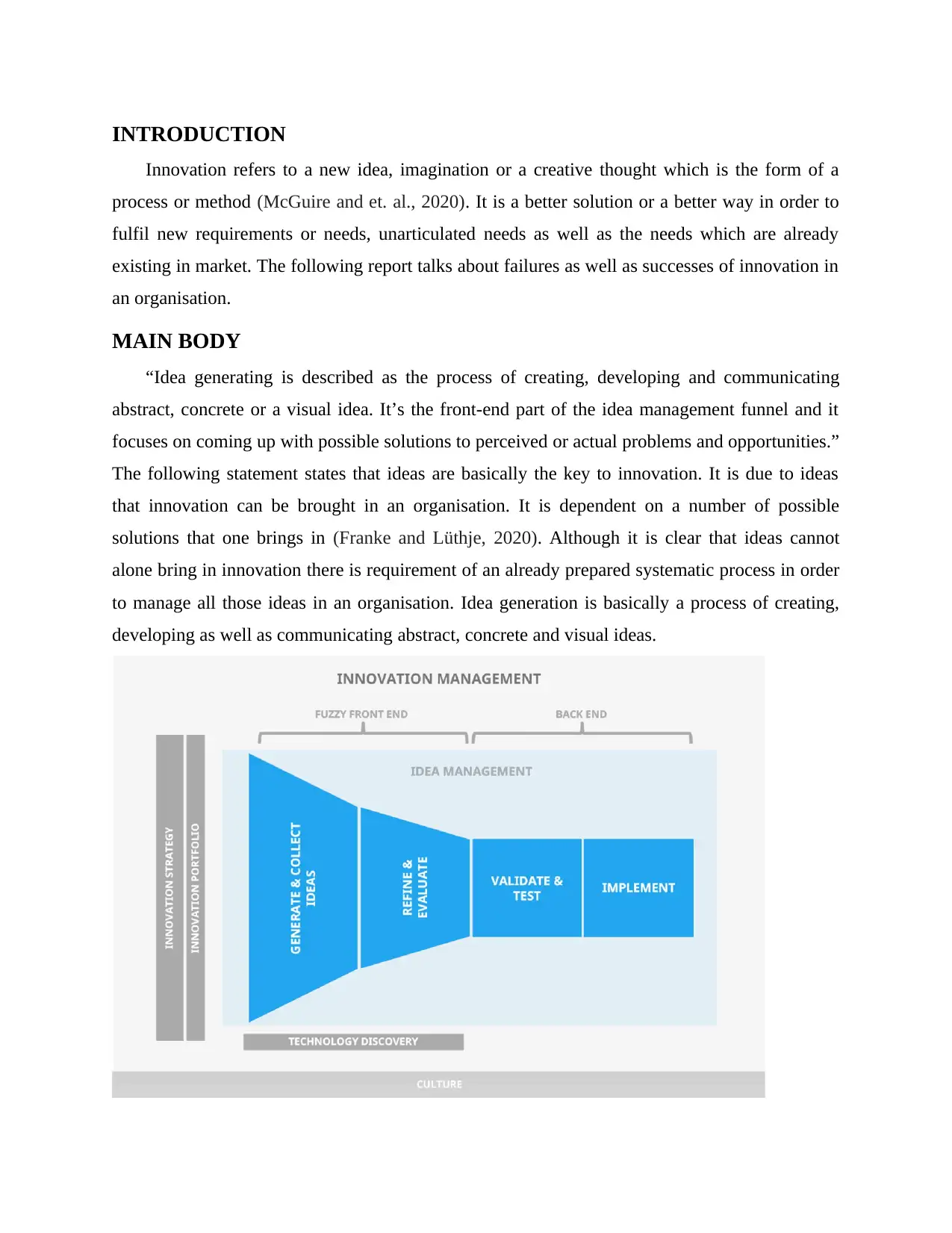
INTRODUCTION
Innovation refers to a new idea, imagination or a creative thought which is the form of a
process or method (McGuire and et. al., 2020). It is a better solution or a better way in order to
fulfil new requirements or needs, unarticulated needs as well as the needs which are already
existing in market. The following report talks about failures as well as successes of innovation in
an organisation.
MAIN BODY
“Idea generating is described as the process of creating, developing and communicating
abstract, concrete or a visual idea. It’s the front-end part of the idea management funnel and it
focuses on coming up with possible solutions to perceived or actual problems and opportunities.”
The following statement states that ideas are basically the key to innovation. It is due to ideas
that innovation can be brought in an organisation. It is dependent on a number of possible
solutions that one brings in (Franke and Lüthje, 2020). Although it is clear that ideas cannot
alone bring in innovation there is requirement of an already prepared systematic process in order
to manage all those ideas in an organisation. Idea generation is basically a process of creating,
developing as well as communicating abstract, concrete and visual ideas.
Innovation refers to a new idea, imagination or a creative thought which is the form of a
process or method (McGuire and et. al., 2020). It is a better solution or a better way in order to
fulfil new requirements or needs, unarticulated needs as well as the needs which are already
existing in market. The following report talks about failures as well as successes of innovation in
an organisation.
MAIN BODY
“Idea generating is described as the process of creating, developing and communicating
abstract, concrete or a visual idea. It’s the front-end part of the idea management funnel and it
focuses on coming up with possible solutions to perceived or actual problems and opportunities.”
The following statement states that ideas are basically the key to innovation. It is due to ideas
that innovation can be brought in an organisation. It is dependent on a number of possible
solutions that one brings in (Franke and Lüthje, 2020). Although it is clear that ideas cannot
alone bring in innovation there is requirement of an already prepared systematic process in order
to manage all those ideas in an organisation. Idea generation is basically a process of creating,
developing as well as communicating abstract, concrete and visual ideas.
⊘ This is a preview!⊘
Do you want full access?
Subscribe today to unlock all pages.

Trusted by 1+ million students worldwide
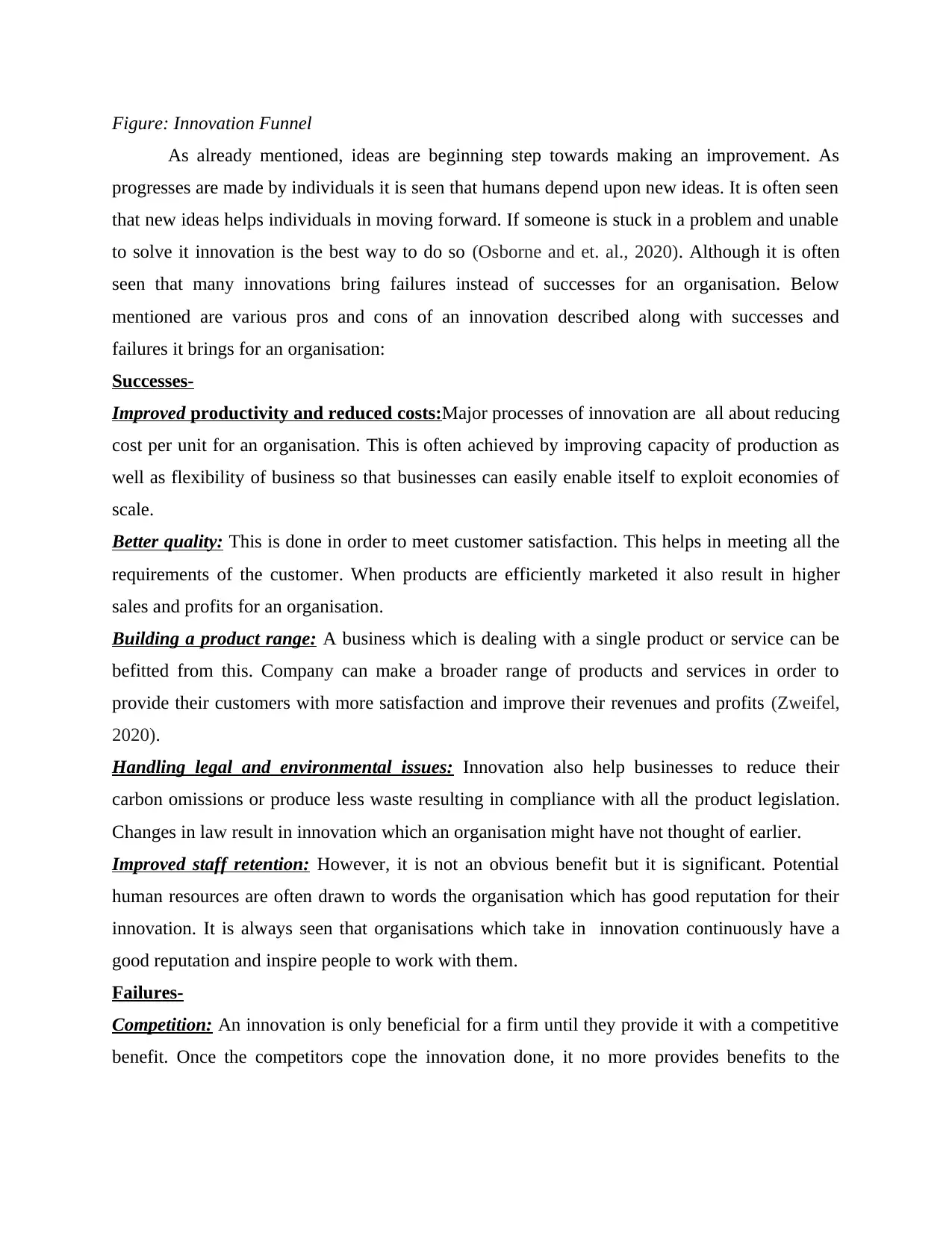
Figure: Innovation Funnel
As already mentioned, ideas are beginning step towards making an improvement. As
progresses are made by individuals it is seen that humans depend upon new ideas. It is often seen
that new ideas helps individuals in moving forward. If someone is stuck in a problem and unable
to solve it innovation is the best way to do so (Osborne and et. al., 2020). Although it is often
seen that many innovations bring failures instead of successes for an organisation. Below
mentioned are various pros and cons of an innovation described along with successes and
failures it brings for an organisation:
Successes-
Improved productivity and reduced costs:Major processes of innovation are all about reducing
cost per unit for an organisation. This is often achieved by improving capacity of production as
well as flexibility of business so that businesses can easily enable itself to exploit economies of
scale.
Better quality: This is done in order to meet customer satisfaction. This helps in meeting all the
requirements of the customer. When products are efficiently marketed it also result in higher
sales and profits for an organisation.
Building a product range: A business which is dealing with a single product or service can be
befitted from this. Company can make a broader range of products and services in order to
provide their customers with more satisfaction and improve their revenues and profits (Zweifel,
2020).
Handling legal and environmental issues: Innovation also help businesses to reduce their
carbon omissions or produce less waste resulting in compliance with all the product legislation.
Changes in law result in innovation which an organisation might have not thought of earlier.
Improved staff retention: However, it is not an obvious benefit but it is significant. Potential
human resources are often drawn to words the organisation which has good reputation for their
innovation. It is always seen that organisations which take in innovation continuously have a
good reputation and inspire people to work with them.
Failures-
Competition: An innovation is only beneficial for a firm until they provide it with a competitive
benefit. Once the competitors cope the innovation done, it no more provides benefits to the
As already mentioned, ideas are beginning step towards making an improvement. As
progresses are made by individuals it is seen that humans depend upon new ideas. It is often seen
that new ideas helps individuals in moving forward. If someone is stuck in a problem and unable
to solve it innovation is the best way to do so (Osborne and et. al., 2020). Although it is often
seen that many innovations bring failures instead of successes for an organisation. Below
mentioned are various pros and cons of an innovation described along with successes and
failures it brings for an organisation:
Successes-
Improved productivity and reduced costs:Major processes of innovation are all about reducing
cost per unit for an organisation. This is often achieved by improving capacity of production as
well as flexibility of business so that businesses can easily enable itself to exploit economies of
scale.
Better quality: This is done in order to meet customer satisfaction. This helps in meeting all the
requirements of the customer. When products are efficiently marketed it also result in higher
sales and profits for an organisation.
Building a product range: A business which is dealing with a single product or service can be
befitted from this. Company can make a broader range of products and services in order to
provide their customers with more satisfaction and improve their revenues and profits (Zweifel,
2020).
Handling legal and environmental issues: Innovation also help businesses to reduce their
carbon omissions or produce less waste resulting in compliance with all the product legislation.
Changes in law result in innovation which an organisation might have not thought of earlier.
Improved staff retention: However, it is not an obvious benefit but it is significant. Potential
human resources are often drawn to words the organisation which has good reputation for their
innovation. It is always seen that organisations which take in innovation continuously have a
good reputation and inspire people to work with them.
Failures-
Competition: An innovation is only beneficial for a firm until they provide it with a competitive
benefit. Once the competitors cope the innovation done, it no more provides benefits to the
Paraphrase This Document
Need a fresh take? Get an instant paraphrase of this document with our AI Paraphraser
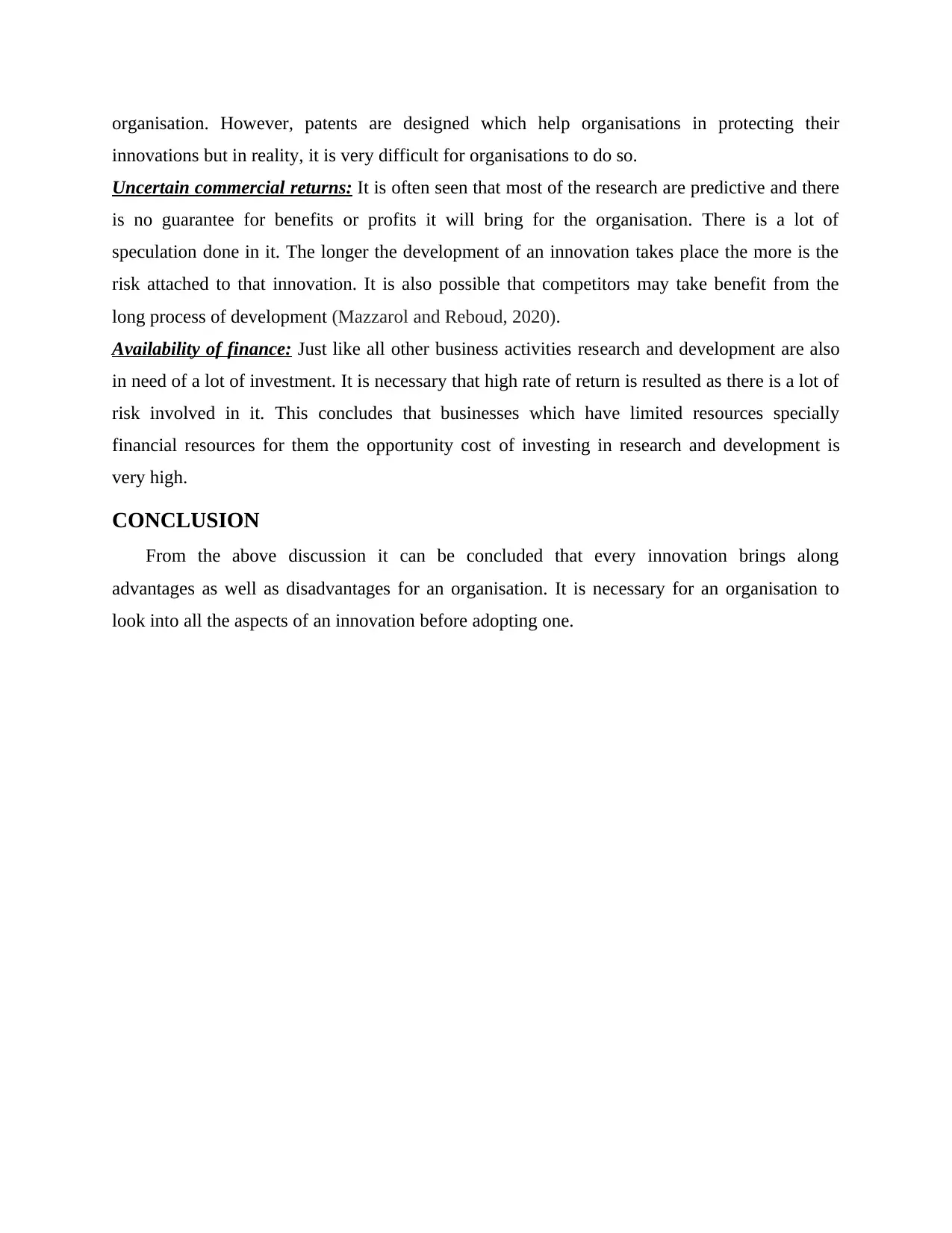
organisation. However, patents are designed which help organisations in protecting their
innovations but in reality, it is very difficult for organisations to do so.
Uncertain commercial returns: It is often seen that most of the research are predictive and there
is no guarantee for benefits or profits it will bring for the organisation. There is a lot of
speculation done in it. The longer the development of an innovation takes place the more is the
risk attached to that innovation. It is also possible that competitors may take benefit from the
long process of development (Mazzarol and Reboud, 2020).
Availability of finance: Just like all other business activities research and development are also
in need of a lot of investment. It is necessary that high rate of return is resulted as there is a lot of
risk involved in it. This concludes that businesses which have limited resources specially
financial resources for them the opportunity cost of investing in research and development is
very high.
CONCLUSION
From the above discussion it can be concluded that every innovation brings along
advantages as well as disadvantages for an organisation. It is necessary for an organisation to
look into all the aspects of an innovation before adopting one.
innovations but in reality, it is very difficult for organisations to do so.
Uncertain commercial returns: It is often seen that most of the research are predictive and there
is no guarantee for benefits or profits it will bring for the organisation. There is a lot of
speculation done in it. The longer the development of an innovation takes place the more is the
risk attached to that innovation. It is also possible that competitors may take benefit from the
long process of development (Mazzarol and Reboud, 2020).
Availability of finance: Just like all other business activities research and development are also
in need of a lot of investment. It is necessary that high rate of return is resulted as there is a lot of
risk involved in it. This concludes that businesses which have limited resources specially
financial resources for them the opportunity cost of investing in research and development is
very high.
CONCLUSION
From the above discussion it can be concluded that every innovation brings along
advantages as well as disadvantages for an organisation. It is necessary for an organisation to
look into all the aspects of an innovation before adopting one.
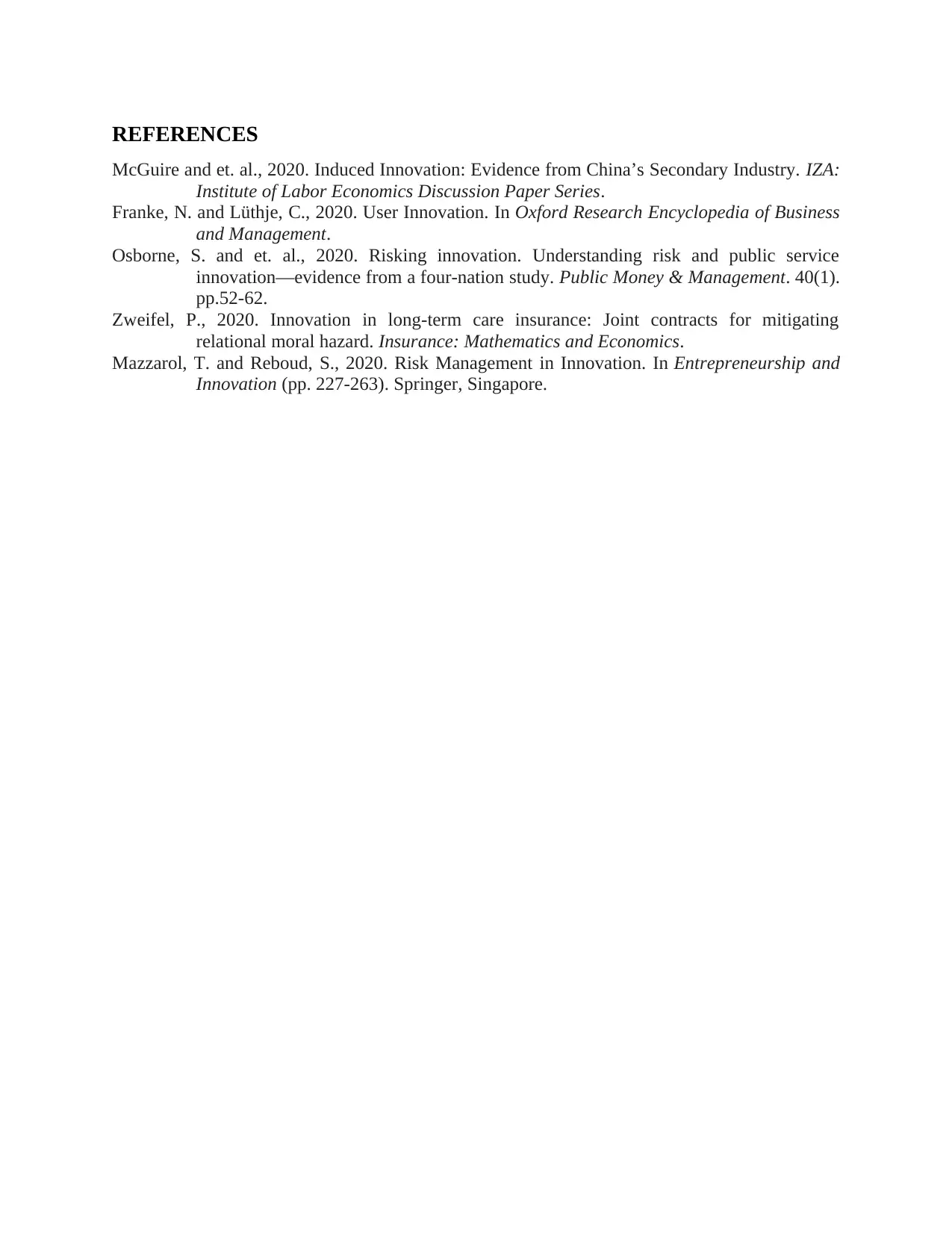
REFERENCES
McGuire and et. al., 2020. Induced Innovation: Evidence from China’s Secondary Industry. IZA:
Institute of Labor Economics Discussion Paper Series.
Franke, N. and Lüthje, C., 2020. User Innovation. In Oxford Research Encyclopedia of Business
and Management.
Osborne, S. and et. al., 2020. Risking innovation. Understanding risk and public service
innovation—evidence from a four-nation study. Public Money & Management. 40(1).
pp.52-62.
Zweifel, P., 2020. Innovation in long-term care insurance: Joint contracts for mitigating
relational moral hazard. Insurance: Mathematics and Economics.
Mazzarol, T. and Reboud, S., 2020. Risk Management in Innovation. In Entrepreneurship and
Innovation (pp. 227-263). Springer, Singapore.
McGuire and et. al., 2020. Induced Innovation: Evidence from China’s Secondary Industry. IZA:
Institute of Labor Economics Discussion Paper Series.
Franke, N. and Lüthje, C., 2020. User Innovation. In Oxford Research Encyclopedia of Business
and Management.
Osborne, S. and et. al., 2020. Risking innovation. Understanding risk and public service
innovation—evidence from a four-nation study. Public Money & Management. 40(1).
pp.52-62.
Zweifel, P., 2020. Innovation in long-term care insurance: Joint contracts for mitigating
relational moral hazard. Insurance: Mathematics and Economics.
Mazzarol, T. and Reboud, S., 2020. Risk Management in Innovation. In Entrepreneurship and
Innovation (pp. 227-263). Springer, Singapore.
⊘ This is a preview!⊘
Do you want full access?
Subscribe today to unlock all pages.

Trusted by 1+ million students worldwide

1 out of 7
Related Documents
Your All-in-One AI-Powered Toolkit for Academic Success.
+13062052269
info@desklib.com
Available 24*7 on WhatsApp / Email
![[object Object]](/_next/static/media/star-bottom.7253800d.svg)
Unlock your academic potential
Copyright © 2020–2025 A2Z Services. All Rights Reserved. Developed and managed by ZUCOL.





